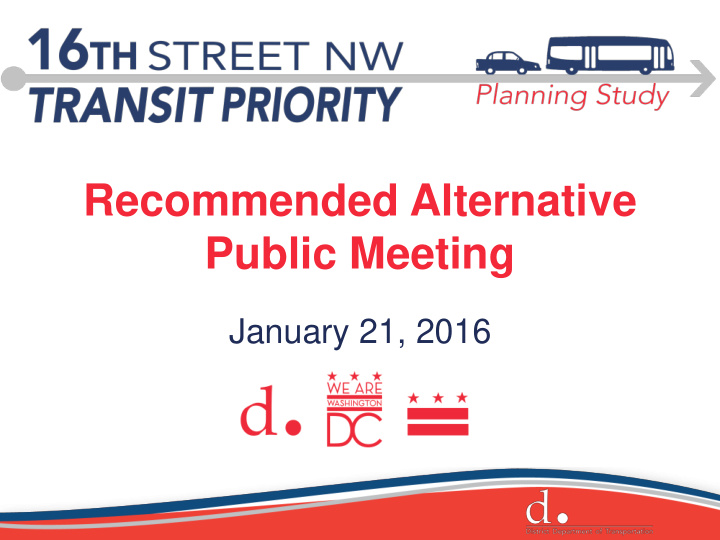



Recommended Alternative Public Meeting January 21, 2016
Agenda 1. Welcome 2. Background 3. Project Overview 4. Data Collection and Analysis 5. Alternatives 6. Recommended Alternative 7. Next Steps
BACKGROUND
Study Area Arkansas Avenue NW Primary Study Area • 16 th Street NW from H Street to Arkansas Avenue 16 th Street NW Secondary Study Area • Bounded by 14 th Street, 18 th Street, Taylor Street and H Street H Street NW
Study Partner WMATA Metrobus
Issues • One of the busiest Metrobus corridors • 20,000+ riders on average weekday • Most trips during peak hours at or above seating capacity • Buses are bunched and generally slow
moveDC moveDC Plan • Transit Priority Corridor 2 Year Action Plan • High Capacity Transit Improvements
PROJECT OVERVIEW
Goals • Improve travel for persons using public transit • Develop alternatives based on public and stakeholder input • Evaluate alternatives in terms of their benefits to transit users, possible impacts on other users of the corridor, and safety
Objectives • Improve transit service reliability and travel times by identifying and addressing sources of problems • Prioritize transit while maintaining operations for those traveling by other modes • Improve rider comfort and safety • Accommodate current unmet passenger demand for public transit service • Develop an implementation plan that includes costs estimates
Project Timeline January 2015 January 2016 Identify Issues Select Project Develop Evaluate and Collect Recommended Kick-Off Alternatives Alternatives Data Alternative March: May: August: Sept./Oct.: Dec.: January: Kick-Off CAG #1 CAG #2 CAG #3 + CAG #4 Public Meeting Meeting Public Engagement Events CAG: Citizens Advisory Group
DATA COLLECTION AND ANALYSIS
Data Sources • AVL/APC data (WMATA) • On-board data • Multimodal counts • Pedestrian access and safety • Roadway configuration and curbside uses • Bus stop zones and amenities
Corridor-Level Bus Findings 1. Bunching 2. Total Trip Times 3. Travel Speed by Time of Day 4. Boardings and Loads 5. Average Bus Operations
Existing S Routes • Multiple service patterns contribute to bunching
Average Bus Operations (Source: On-Board Data Collection) Overall Peak Period Peak Direction Averages Doors Open Time 20% 53% Signal/Stop Delay Before Loading Delay Congestion Delay & 22% Other Delays Bus in Motion 1% 5% Note: Congestion also impacts the time the bus is in motion
Segment Analysis
ALTERNATIVES
Overview of Alternatives • Alternative 1: Service Focus • Alternative 2: Infrastructure Focus • Alternative 3: Mixed Service and Infrastructure
Alternatives Matrix
What We Heard • Large support for bus lanes and off-board fare payment for all buses • Some concern about S1/2/4 truncation, S1 conversion to limited stop service, stop consolidation, Arkansas Avenue deadhead, left turn restrictions, and parking
Alternatives Analysis • Transit dwell and travel time estimations • Multimodal VISSIM model • Verification of physical space needs and feasibility • Cost estimates
RECOMMENDED ALTERNATIVE
Recommended Alternative Matrix
Recommended Alternative • Peak-hour peak-direction bus lanes – Southbound in the AM Peak (7 – 10 AM) – Northbound in the PM Peak (4 to 7:30 PM) – Reversible lane from Arkansas Avenue to K Street – Addition of 5th lane from W to O Street and K to H Street – Automated enforcement of bus lanes
Recommended Alternative • Off-board fare payment and all-door boarding • Bus stop consolidation • Headway-based service supported by transit signal priority • Increase limited stop service and transition to simpler patterns
Recommended Alternative: Bus Travel Time Savings AM Peak Estimated PM Peak Estimated Travel Time Savings Travel Time Savings S1/S2/S4 5.9 minutes 2.0 minutes Southbound S9 Southbound 3.7 minutes 0.8 minutes S1/S2/S4 2.4 minutes 5.9 minutes Northbound S9 Northbound 1.1 minutes 4.6 minutes
Recommended Alternative: General Vehicle Travel Times AM Peak Estimated PM Peak Estimated Travel Time Increase Travel Time Increase Southbound No Change 1.9 minutes Northbound 1.5 minutes 2.0 minutes
Recommended Alternative: Cost Estimate • Estimated capital cost is $6 million – Includes design, construction, equipment, and contingency • Estimated operating cost is under development – Will be finalized as service changes are better defined
Let’s take a ride!
Boarding the Bus Bus Lane Photo: NYC DOT
Note: Sign times would be different for 16 th Street Photo: NYC DOT Bus Lane
Reversible Lane Photos: orangetraffic.com Google maps
NEXT STEPS
Plan for Implementation
Implementation • Broken down into three phases: 1. <18 months 2. 2 to 4 years 3. 4+ years • DDOT and WMATA both leading elements of implementation – DDOT lead is PTSA • Bus lanes open in 2 to 4 years
Ongoing Public Engagement • CAG meetings twice a year – Open to the public – Additional meetings during design phase • Project email updates • Coordination with WMATA public participation process
Comment on the Recommended Alternative • Submit comments at today’s meeting – Comment card – Post-its on large map • Email Megan Kanagy through January 25 th at megan.kanagy@dc.gov
Stay Connected Megan Kanagy, Project Manager (Planning) megan.kanagy@dc.gov Spring Worth, Project Manager (Implementation) spring.worth@dc.gov Project Website bit.ly/16thStreetBus
Recommend
More recommend